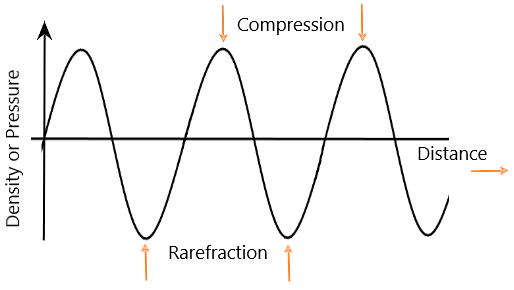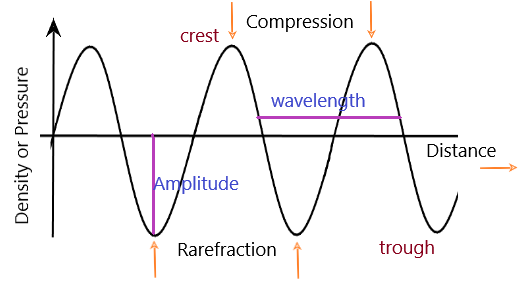
Draw a curve showing density or pressure variations with respect to distance for a disturbance produced by sound. Mark the position of compression and rarefaction on this curve. Also define wavelengths and time period using this curve.


Answer
543k+ views
Hint: We need to keep in mind the following definitions.
Wavelength is the distance between two consecutive points having the same phase.
Time period is the time taken for a complete oscillation.
Frequency is the inverse of time period. It is given by the number of complete oscillations per unit time.
Complete step by step answer:
Wavelength is the distance between any two consecutive points having the same phase,
It is a characteristic of both traveling and standing waves. Wavelength is generally denoted by λ.
The amplitude is the height of the curve, i.e. the maximum or minimum density or pressure attained by the wave.
Time period is the time taken for a complete oscillation. Frequency is the inverse of time period. It is given by the number of complete oscillations per unit time. The unit for frequency is Hertz (Hz) where the value of 1 Hz is equivalent to 1 cycle/second or cps.
The diagram below shows the density or pressure variations with respect to distance for a sound wave.

Note: Wavelength is the distance between any two consecutive points having the same phase,
It is a characteristic of both traveling and standing waves. Wavelength is generally denoted by λ.
The amplitude is the height of the curve, i.e. the maximum or minimum density or pressure attained by the wave.
Wavelength is the distance between two consecutive points having the same phase.
Time period is the time taken for a complete oscillation.
Frequency is the inverse of time period. It is given by the number of complete oscillations per unit time.
Complete step by step answer:
Wavelength is the distance between any two consecutive points having the same phase,
It is a characteristic of both traveling and standing waves. Wavelength is generally denoted by λ.
The amplitude is the height of the curve, i.e. the maximum or minimum density or pressure attained by the wave.
Time period is the time taken for a complete oscillation. Frequency is the inverse of time period. It is given by the number of complete oscillations per unit time. The unit for frequency is Hertz (Hz) where the value of 1 Hz is equivalent to 1 cycle/second or cps.
The diagram below shows the density or pressure variations with respect to distance for a sound wave.

Note: Wavelength is the distance between any two consecutive points having the same phase,
It is a characteristic of both traveling and standing waves. Wavelength is generally denoted by λ.
The amplitude is the height of the curve, i.e. the maximum or minimum density or pressure attained by the wave.
Recently Updated Pages
Master Class 8 Maths: Engaging Questions & Answers for Success

Class 8 Question and Answer - Your Ultimate Solutions Guide

Master Class 7 Maths: Engaging Questions & Answers for Success

Class 7 Question and Answer - Your Ultimate Solutions Guide

Master Class 6 Maths: Engaging Questions & Answers for Success

Class 6 Question and Answer - Your Ultimate Solutions Guide

Trending doubts
What is meant by exothermic and endothermic reactions class 11 chemistry CBSE

Which animal has three hearts class 11 biology CBSE

10 examples of friction in our daily life

One Metric ton is equal to kg A 10000 B 1000 C 100 class 11 physics CBSE

1 Quintal is equal to a 110 kg b 10 kg c 100kg d 1000 class 11 physics CBSE

Difference Between Prokaryotic Cells and Eukaryotic Cells




